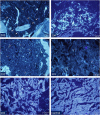Severe neurodegenerative disease in brothers with homozygous mutation in POLR1A
- PMID: 28051070
- PMCID: PMC5334463
- DOI: 10.1038/ejhg.2016.183
Severe neurodegenerative disease in brothers with homozygous mutation in POLR1A
Abstract
In two brothers born to consanguineous parents, we identified an unusual neurological disease that manifested with ataxia, psychomotor retardation, cerebellar and cerebral atrophy, and leukodystrophy. Via linkage analysis and exome sequencing, we identified homozygous c.2801C>T (p.(Ser934Leu)) in POLR1A (encoding RPA194, largest subunit of RNA polymerase I) and c.511C>T (p.(Arg171Trp)) in OSBPL11 (encoding oxysterol-binding protein-like protein 11). Although in silico analysis, histopathologic evidence and functional verification indicated that both variants were deleterious, segregation with the patient phenotype established that the POLR1A defect underlies the disease, as a clinically unaffected sister also was homozygous for the OSBPL11 variant. Decreased nucleolar RPA194 was observed in the skin fibroblasts of only the affected brothers, whereas intracellular cholesterol accumulation was observed in the skin biopsies of the patients and the sister homozygous for the OSBPL11 variant. Our findings provide the first report showing a complex leukodystrophy associated with POLR1A. Variants in three other RNA polymerase subunits, POLR1C, POLR3A and POLR3B, are known to cause recessive leukodystrophy similar to the disease afflicting the present family but with a later onset. Of those, POLR1C is also implicated in a mandibulofacial dysostosis syndrome without leukodystrophy as POLR1A is. This syndrome is absent in the family we present.
Conflict of interest statement
The authors declare no conflict of interest.
Figures




References
-
- Grummt I: Wisely chosen paths—regulation of rRNA synthesis. FEBS J 2010; 277: 4626–4639. - PubMed
Publication types
MeSH terms
Substances
Grants and funding
LinkOut - more resources
Full Text Sources
Other Literature Sources
Medical
Molecular Biology Databases

